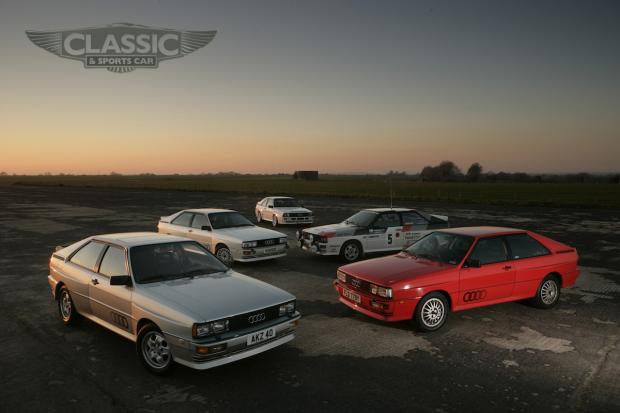As if the famous Audi Sport livery wasn’t evocative enough, spotting Mikkola’s name and blood type on the door builds the sense of occasion before you’ve even clambered over the hefty rollcage and dropped into the bucket seat. In addition to looking right, this replica drives as the real deal should, too, with a period-correct 300bhp-plus – and seemingly all of it arriving between 5000 and 7000rpm.
There’s plenty of performance and lots of noise, most of it the chattering of stones on the underside. That’s no surprise, given that where once sat rear seats and carpets is now bare metal. What does surprise is the comfort and ease with which this old stager can be driven: the steering is still power-assisted and the gearbox is – and was – a standard Audi 100 unit because the team couldn’t find anything stronger. Rally drivers never had it so easy.

CAREER HIGHS FOR A FOUR-WHEEL-DRIVE MARVEL
1981 Mikkola 3rd, wins in Sweden, UK (right); Mouton 8th, win in Italy; Audi 5th
1982 Mouton 2nd, wins in Portugal, Brazil and Greece; Mikkola 3rd, wins in Finland and UK; Blomqvist 4th, wins in Sweden, Italy; Audi champion
1983 Mikkola champ, wins in Sweden/Portugal (A1), plus Argentina/Finland (A2); Blomqvist 4th, win in UK (A2); Audi 2nd
1984 Blomqvist champion, wins in Sweden (above right), Greece, New Zealand, Argentina (A2), plus Ivory Coast (S1); Mikkola 2nd, win in Portugal (A2); Röhrl 11th, win on Monte (A2); Audi champion
1985 Blomqvist 2nd; Röhrl 3rd, win in Italy (E2); Audi 2nd; Mouton wins Pikes Peak (S1); Mikkola wins HK-Beijing Rally (A2) 1986 Unser Snr wins Pikes Peak (S1); Blomqvist wins HK-Beijing (A2) 1987 Röhrl wins Pikes Peak (E2, above)

QUATTROS THAT BROKE THE MOULD
Despite the quality of its drivetrain, there have been few bespoke quattros. But German coachbuilder Günter Artz did produce a neat ‘Kombi’ (below), with huge side windows and wraparound glass tailgate. Artz also created a practical Q-car, using VW Passat parts to turn the Audi 200 into an estate, sitting on a stretched quattro floorpan.
Pininfarina’s interpretation of the quattro followed a year after the original. The quartz (below left) was a study of lightweight materials – Kevlar, carbonfibre, steel/polypropylene, polycarbonate and parachute fabric. It weighed 90kg less than a standard car, despite gimmickery such as a tyre pressure monitor, computer and four-ringed tailpipes. It never got further than the concept stage, but Pininfarina recycled the design’s projector headlamps and body groove in its front-drive Alfa Spider.
The man best qualified to modify the quattro was Walter Treser. He began with a 250bhp coupé, but his most memorable offering was the 1983 Treser Roadster, complete with fold-away hardtop (C&SC, December ’06).
Most extreme quattro was the 1986 Sport RS 002 (above). When Group B – and its Group S offshoot – ended, this stubby 175mph beastie was mothballed, later reappearning in Audi’s Museum Mobile. It boasted a composite body, tubular spaceframes at each end of the tub and a mid-mounted 500bhp five-pot motor.
FACTFILES
Audi Ur-quattro
Sold/number built 1980-‘91/11,452 (all quattros) Construction steel monocoque
Engine
front-mounted, longitudinal, iron-block, alloy-head sohc 2144cc ‘five’,
with two valves per cylinder, Bosch K-Jetronic fuel injection and KKK
turbocharger with intercooler
Max power 200bhp @ 5500rpm
Max torque 210lb ft @ 3500rpm
Transmission five-speed manual with integral centre differential, driving all four wheels
Suspension: front and rear MacPherson struts, anti-roll bars (front only from 1982)
Steering power-assisted rack and pinion
Brakes 11in (280mm) vented front discs,
9 n (244mm) solid rears, with servo
Wheels & tyres 6J x 15 Ronal alloy (7J Fuchs optional), 205/60 VR15
Length 14ft 5 n (4404mm) Width 5ft 7in (1723mm) Height 4ft 5in (1346mm)
Wheelbase 8ft 3 n (2524mm)
Front track 4ft 7in (1422mm)
Rear track 4ft 8 n (1455mm)
Weight 2844lb (1290kg)
0-60mph 6.5 secs
Top speed 138mph Mpg 19.9
Price new £14,500 (1981)
Audi Sport quattro
Sold/number built 1984-’86/224
Construction steel monocoque with Kevlar reinforced glassfibre panels Engine
front-mounted, longitudinal, all-alloy dohc 2134cc ‘five’, with four
valves per cylinder, Bosch LH-Jetronic fuel injection and KKK
turbocharger with intercooler (iron-block 2226cc on this car)
Max power 306bhp @ 6700rpm
Max torque 258lb ft @ 3700rpm
Transmission five-speed manual transaxle with integral centre diff, driving all four wheels
Suspension: front and rear MacPherson struts, anti-roll bars Steering power-assisted rack and pinion Brakes 11in (280mm) vented discs, with servo and Bosch anti-lock
Wheels & tyres 9J x 15 Ronal alloy, 225/40 or 235/40 VR15 (16in magnesium on this car with 245/35 ZR16 tyres) Length 13ft 7in (4160mm) Width 5ft 10in (1780mm) Height 4ft 5in (1345mm) Wheelbase 7ft 3 n (2224mm) Front track 4ft 10 n (1487mm) Rear track 4ft 10 n (1485mm)
Weight 2807lb (1273kg) 0-60mph 4.8 secs
Top speed 154mph Mpg 15.3
Price new £51,282 (1985)
Audi quattro 20v
Sold/number built 1988-‘91/see Ur-quattro
Construction steel monocoque Engine
front-mounted, longitudinal, iron-block, alloy-head dohc 2226cc ‘five’,
with four valves per cylinder, fuel injection and turbocharger with
intercooler Max power 220bhp @ 5900rpm Max torque 228lb ft @ 1950rpm Transmission five-speed manual, driving all four wheels via Torsen centre diff Suspension MacPherson struts, anti-roll bars Steering power-assisted rack and pinion Brakes 11in (276mm) vented front discs, 9 n (245mm) solid rears, with servo and ABS Wheels/tyres 8J x 15 Ronal alloy, 215/50 R15 Length 14ft 5 n (4404mm) Width 5ft 7in (1723mm)
Height 4ft 5in (1344mm) Wheelbase 8ft 3 n (2524mm) Front track 4ft 9 n (1461mm) Rear track 4ft 10in (1494mm) Weight 3069lb (1395kg) 0-60mph 6.3 secs
Top speed 141mph Mpg 19.1 Price new £33,452 (1990)
Audi quattro rally car
Produced 1981, for Rallye Monte-Carlo
Construction steel monocoque with aluminium rollcage, bonnet and front wings
Engine
front-mounted, longitudinal, iron-block, alloy-head sohc 2144cc ‘five’,
with dry sump, two valves per cylinder, Pierburg fuel injection and KKK
turbocharger (2226cc block in replica)
Max power 300-360bhp @ 6300rpm
Max torque 325lb ft @ 4000rpm
Transmission
five-speed manual with locked centre differential, free front diff and
limited-slip rear diff, driving all four wheels
Suspension MacPherson struts, anti-roll bars
Steering power-assisted rack and pinion
Brakes 11in (280mm) AP vented discs, with alloy calipers and adjustable balance
Wheels/tyres 6J Fuchs alloy, 195/65 R15 M+S
Length
14ft 5 n (4404mm) Width 5ft 8 n (1733mm) Height 4ft 5in (1344mm)
Wheelbase 8ft 3 n (2524mm) Front track 4ft 9in (1465mm) Rear track 4ft
11 n (1502mm) Weight 2619lb (1188kg, inc crew)
0-60mph 4.9 secs Top speed 160mph
This article originally appeared in the May 2008 issue of Classic & Sports Car magazine, which retains the copyright to all words and images.
Alastair Clements
Alastair is Editor in Chief of Classic & Sports Car and has been associated with the brand for more than 20 years











